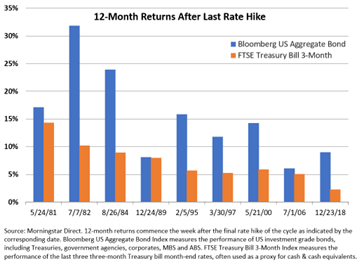
Good question. Financial markets (stock and bonds) tend to oscillate returns like a swinging pendulum. More drastic negative returns are often accompanied by higher positive returns and vice versa. Though we never know the market’s maxima (highest point of a pendulum’s sway before swinging back), the market pendulum ultimately reverses course. This is often referred to as mean-reversion. Bond market swings are not as drastic as stock market oscillations, but the mean-reversion relationship holds.
Since 1981, there have been nine Federal Reserve (Fed) induced rate hike cycles. In every case, bonds out-performed cash in the 12 months following the last rate hike. In most cases, bonds dramatically out-performed cash. This high consistency suggests there may be an underlying cause, which just happens to be the Fed.
The Federal Reserve has a dual mandate; price stability (i.e., low inflation) and maximum employment. These mandates are often juxtaposed to each other. The Fed’s primary tool of choice is interest rate control. If inflation (or the prospects of inflation) is too rich, raise rates; when the economy sputters, lower rates. Hence, the ebb and flow of interest rates. For background, yields and bond prices are inversely related. So rising rates are corrosive to bond returns, while lowering rates is accretive.
Fast forward to today, per Fed commentary and market expectations, the Fed’s rate hike cycle is complete. The past 14 months of rate increases has threatened economic activity with recessionary markers flashing. Once the Fed feels high inflation has been conquered, the next step is to repair the economic damage created via lowering rates. Historically, rate cuts follow 3-8 months after the last rate hike. Lowering rates induce bond price gains. Such bond appreciation coupled together with bond coupons generate superior total returns to cash, which only offer yields as their only component of total return.
On the cash side, yields fluctuate closely following the Fed controlled Fed Funds Rate. Hence, cash yields will drop as the Fed lowers rates. Wealth-based portfolios are strategically designed to accomplish long-term goals and objectives. It is tempting to focus on the near-term, which often comes at the detriment of long-term accomplishments. As they say in baseball, “keep your eye on the ball.”
1US Department of the Treasury, treasury.gov
CRN-5681605-051123


Recent Comments